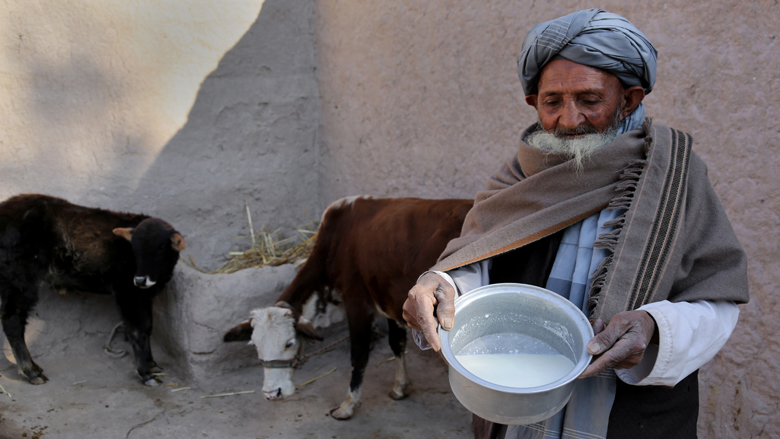KHAIWA DISTRICT, Nangarhar Province – It is a sunny afternoon in Barshad Khan village. A group of young and elderly men have gathered, discussing milk prices and consulting the notebooks in their hands, while their cows are out to pasture nearby.
One of the men, Ghulam Haidar, 62, is reading from his notebook in which he has recorded his earnings: “My monthly income from milk collection is about 18,000 afghanis (around $260).” It is good extra income to his main income of selling vegetables, he says. With the extra earnings, the father of 10 says his children can go to school and he can meet their needs. “I am so thankful that I make halal money for myself and my children’s future.”
Ghulam Haidar and 31 other residents of Barshad Khan village, in Khaiwa district in Nangarhar province, are profiting by doing business with a milk collection center, named “Parmakhtak” in Pashto, which was set up two years ago. Through the center, Ghulam Haidar has learned to use the milk from his cows for profit. “I have learned not to waste a single drop of milk,” he says, “I keep orderly accounts. I collect the milk and bring it to the center. They sell it to a dairy company and I get paid well.”
Barshad Khan village milk collection center is one of three centers in the province set up by a Producer Association established by the Afghanistan Rural Enterprise Development Program (AREDP). As a result of AREDP’s work, many, like Ghulam Haidar, found that the cows they had always kept for personal use could be used as a source of income.
Imam Jan, an AREDP employee in the village, points out how the program has changed the lives of residents. “There were dozens of cows in this village, but people never thought of turning them into a source of income. However, when the project came to the village, things changed. AREDP’s activities were the most beneficial experience for the residents of this village.”
AREDP is a program of the Ministry of Rural Rehabilitation and Development (MRRD), started in 2010, with an aim to increase the employment and income of rural men and women. It receives funding support from the International Development Association (IDA), the World Bank Group’s fund for the poorest countries, and the Afghanistan Reconstruction Trust Fund (ARTF), administered by the World Bank on behalf of 34 donor countries.
AREDP is currently active in five of the 34 provinces in Afghanistan: Balkh, Bamyan, Herat, Nangarhar, and Parwan. The program works to improve economic activity among the rural poor by organizing them into various types of groups, such as Savings Groups, Village Savings and Loan Associations, and Enterprise Groups (EGs). Producer Associations are formed by several EGs coming together. Since 2010, the program has been active in seven districts of Nangarhar province and has set up 1,280 EGs and 62 Producer Associations.

